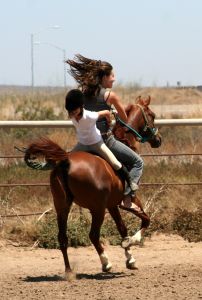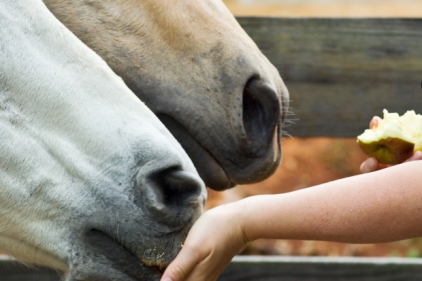If you grew up around horses and were taught by a parent or riding instructor, the common sense advice in this article might seem a little unnecessary or redundant to you. But even as a kid growing up with horses, there were a few things I learned the hard way! It’s so much better to learn from other’s mistakes, read about it, and make a mental note to never let that actually happen to you or your horse. So I’m sharing some practical tips to avoid accidents and keep you and your horse safe.
Know how to safely tie a horse.
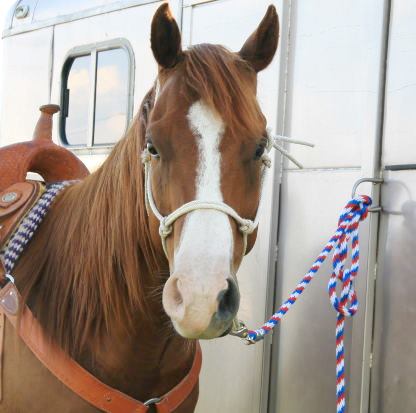 There are several contributing factors here: how the rope is formed, what you tie to, the location of the horse, and how much slack is in the rope. If you haven’t learned how to tie a quick-release knot, view the link for an easy tutorial. Never tie to something weak, such as a portable corral panel, gate, or fence rail. Never tie in an unsafe area, such as next to farm machinery, barbed wire, or too close to another horse. Don’t leave too much slack in the rope between the horse and the knot. About 3 feet is sufficient, and tie as near eye-level with the horse as possible. Tying a horse too low or too long will leave the door open for huge accidents such as the horse getting a leg over the rope, pulling back, falling down, and possibly breaking its neck.
There are several contributing factors here: how the rope is formed, what you tie to, the location of the horse, and how much slack is in the rope. If you haven’t learned how to tie a quick-release knot, view the link for an easy tutorial. Never tie to something weak, such as a portable corral panel, gate, or fence rail. Never tie in an unsafe area, such as next to farm machinery, barbed wire, or too close to another horse. Don’t leave too much slack in the rope between the horse and the knot. About 3 feet is sufficient, and tie as near eye-level with the horse as possible. Tying a horse too low or too long will leave the door open for huge accidents such as the horse getting a leg over the rope, pulling back, falling down, and possibly breaking its neck.
Don’t leave the halter hanging.
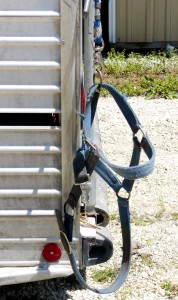 This is something you might not think of, and one can easily fall into a habit of doing. But it is extremely dangerous to slip the halter off the horse and leave it tied to something, posing a hazard to horses passing by who could easily get a leg caught in it and not be able to get free. Anyone who has seen a horse get caught or tangled knows how explosive and powerful they can be, and any number of bad things can happen when a horse doesn’t understand why his legs aren’t working the way he wants them to! Don’t chance a bad accident just because you’re in too much of a hurry to untie your halter. You can still leave it hanging on the trailer, just don’t leave it tied. Horses seem to possess the unique ability to find that one place they shouldn’t put their foot, so we need to take precautions like this to keep them safe.
This is something you might not think of, and one can easily fall into a habit of doing. But it is extremely dangerous to slip the halter off the horse and leave it tied to something, posing a hazard to horses passing by who could easily get a leg caught in it and not be able to get free. Anyone who has seen a horse get caught or tangled knows how explosive and powerful they can be, and any number of bad things can happen when a horse doesn’t understand why his legs aren’t working the way he wants them to! Don’t chance a bad accident just because you’re in too much of a hurry to untie your halter. You can still leave it hanging on the trailer, just don’t leave it tied. Horses seem to possess the unique ability to find that one place they shouldn’t put their foot, so we need to take precautions like this to keep them safe.
In a horse wreck, don’t try to save the day.
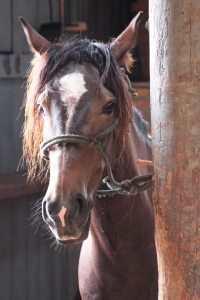 This is advice I received from a very experienced horse trainer who had scars on his face from when a horse he was riding got caught in a gate and blew up, pulling the gate into him and his rider. He told me about a girl who went into a stall to try to help a horse that was tied and freaking out, and the horse reared up and knocked her in the head with a front hoof and she died. I was asking his advice about training a horse to tie that pulls back and had broken a couple of halters. He said to tie her with a strong rope halter to a sturdy tree with a good rope that wouldn’t slip down. Then stay away. He said watch her and if she gets in a bind, let her struggle. She will find she can’t break the rope, halter, or tree, and that it hurts to pull back and she will stop trying to break halters. He said to never go in to “save” a horse that is hung up or fighting and struggling to get free. Wait until the horse has decided it cannot get loose, and when the horse relaxes, go in and untie it or cut the rope if it’s tangled. But do not put yourself in danger. Chances are the horse will come out of it just fine, but you can easily get hurt by getting close to a horse that is frightened and freaking out. Wait until the tension eases, and then go carefully to release the horse.
This is advice I received from a very experienced horse trainer who had scars on his face from when a horse he was riding got caught in a gate and blew up, pulling the gate into him and his rider. He told me about a girl who went into a stall to try to help a horse that was tied and freaking out, and the horse reared up and knocked her in the head with a front hoof and she died. I was asking his advice about training a horse to tie that pulls back and had broken a couple of halters. He said to tie her with a strong rope halter to a sturdy tree with a good rope that wouldn’t slip down. Then stay away. He said watch her and if she gets in a bind, let her struggle. She will find she can’t break the rope, halter, or tree, and that it hurts to pull back and she will stop trying to break halters. He said to never go in to “save” a horse that is hung up or fighting and struggling to get free. Wait until the horse has decided it cannot get loose, and when the horse relaxes, go in and untie it or cut the rope if it’s tangled. But do not put yourself in danger. Chances are the horse will come out of it just fine, but you can easily get hurt by getting close to a horse that is frightened and freaking out. Wait until the tension eases, and then go carefully to release the horse.
Be careful when mounting or dismounting.
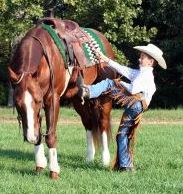 The way the cowboys do it isn’t always the safest way. Everyone who’s watched a western recalls seeing a cowboy shove his boot in the stirrup and swing on as his horse takes off in a dead run, or even take a run and jump over the back end of a horse to get on! But in real life, you need to be careful. Having one foot on the ground and one in the stirrup is a very precarious position, and if the horse spooks at the wrong time, you could wind up under the horse being drug by your foot still caught in the stirrup. So be sure to have your reins in your hand, a good grip on the saddle horn, no more than the toe of your boot in the stirrup, and don’t bump or kick the horse as you swing your other leg over to the other side. Insist on the horse remaining still when you get on. When dismounting, make sure your feet are completely out of the stirrups or at least your left foot is only slightly in, before dropping to the ground. Mounting and dismounting is a dangerous time because the rider is often off balance and preoccupied with getting on rather than watching and controlling the horse. The young cowboy pictured here should either have an adult holding the horse for him or else have a firm hand on the reins while he is climbing on.
The way the cowboys do it isn’t always the safest way. Everyone who’s watched a western recalls seeing a cowboy shove his boot in the stirrup and swing on as his horse takes off in a dead run, or even take a run and jump over the back end of a horse to get on! But in real life, you need to be careful. Having one foot on the ground and one in the stirrup is a very precarious position, and if the horse spooks at the wrong time, you could wind up under the horse being drug by your foot still caught in the stirrup. So be sure to have your reins in your hand, a good grip on the saddle horn, no more than the toe of your boot in the stirrup, and don’t bump or kick the horse as you swing your other leg over to the other side. Insist on the horse remaining still when you get on. When dismounting, make sure your feet are completely out of the stirrups or at least your left foot is only slightly in, before dropping to the ground. Mounting and dismounting is a dangerous time because the rider is often off balance and preoccupied with getting on rather than watching and controlling the horse. The young cowboy pictured here should either have an adult holding the horse for him or else have a firm hand on the reins while he is climbing on.
Watch your overhead.
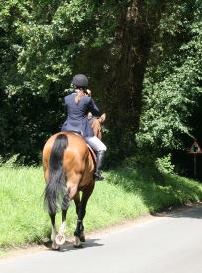 This is a good one for kids and beginners: when you are riding, be aware of the direction your horse is going and try to foresee any danger and avoid it. So many times I see first-time riders let their horse go under a low-hanging tree branch and either get a big scratch on their neck or get knocked off their horse. Then it seems they’re mad at the horse! I always tell my kids to be in control and direct their horse—don’t just be a passenger. Look ahead for low branches, or areas that are too narrow where a rider’s foot could get caught or painfully crunched against a tree or gate. Also keep in mind when riding in a group that the lead horse is often the “lookout” horse and will be more prone to spooking at something than the ones following behind. For those who aren’t used to riding, these are very helpful pointers that can prevent accidents and injuries.
This is a good one for kids and beginners: when you are riding, be aware of the direction your horse is going and try to foresee any danger and avoid it. So many times I see first-time riders let their horse go under a low-hanging tree branch and either get a big scratch on their neck or get knocked off their horse. Then it seems they’re mad at the horse! I always tell my kids to be in control and direct their horse—don’t just be a passenger. Look ahead for low branches, or areas that are too narrow where a rider’s foot could get caught or painfully crunched against a tree or gate. Also keep in mind when riding in a group that the lead horse is often the “lookout” horse and will be more prone to spooking at something than the ones following behind. For those who aren’t used to riding, these are very helpful pointers that can prevent accidents and injuries.
Don’t race home.
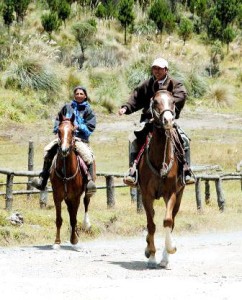 My mother grew up riding horses, and one warning she always gave us as kids was “don’t let your horse run home.” She had learned the hard way that kids riding horses in a group will often get to showing off or seeing whose horse is fastest. But there’s no quicker way to ruin a good horse than letting him run on the way home. Barn sourness is a vice that is already too prevalent in horses—don’t contribute to your horse’s desire to hurry home by racing or galloping towards the barn. It is a childish practice and can lead to horses bucking or kicking out at each other while running in a group. It can also turn a good horse into a “runaway” that is not safe for anyone to ride. When you do lope your horse in the open (outside an arena), take precautions to remain in control and have a direct plan for the horse’s movement, speed, and direction. It’s foolish to give a horse free rein and unlimited speed when riding, and often results in someone getting hurt and a good horse being ruined.
My mother grew up riding horses, and one warning she always gave us as kids was “don’t let your horse run home.” She had learned the hard way that kids riding horses in a group will often get to showing off or seeing whose horse is fastest. But there’s no quicker way to ruin a good horse than letting him run on the way home. Barn sourness is a vice that is already too prevalent in horses—don’t contribute to your horse’s desire to hurry home by racing or galloping towards the barn. It is a childish practice and can lead to horses bucking or kicking out at each other while running in a group. It can also turn a good horse into a “runaway” that is not safe for anyone to ride. When you do lope your horse in the open (outside an arena), take precautions to remain in control and have a direct plan for the horse’s movement, speed, and direction. It’s foolish to give a horse free rein and unlimited speed when riding, and often results in someone getting hurt and a good horse being ruined.
Open gates wide when leading a horse through.
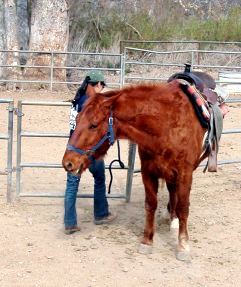 This is especially important for young horses in training, as they are easily frightened if the stirrup bumps the gate or gets hung up on a narrow opening. Watch tricky spots like trailer gates or stall doors where a latch could stick out and catch a horse’s saddle or bridle. Just one instance where a horse gets caught on something can change his whole outlook on life: for instance, next time you ask him to go through the gate he will balk or refuse. If he has trouble in the horse trailer, he will develop a fear of it and refuse to load. You can prevent a serious problem if you just watch for little things that could set the horse off. They tend to remember trauma, and vices are formed when these types of things aren’t prevented. It’s so much better to ward off disaster by staying aware and watching out for potential risks when handling your horse.
This is especially important for young horses in training, as they are easily frightened if the stirrup bumps the gate or gets hung up on a narrow opening. Watch tricky spots like trailer gates or stall doors where a latch could stick out and catch a horse’s saddle or bridle. Just one instance where a horse gets caught on something can change his whole outlook on life: for instance, next time you ask him to go through the gate he will balk or refuse. If he has trouble in the horse trailer, he will develop a fear of it and refuse to load. You can prevent a serious problem if you just watch for little things that could set the horse off. They tend to remember trauma, and vices are formed when these types of things aren’t prevented. It’s so much better to ward off disaster by staying aware and watching out for potential risks when handling your horse.
While these tips might seem overstated, you can never underestimate people’s carelessness or stupidity. For your amusement, here are a few more examples of mistakes in horse-handling:
It’s all funny until someone gets hurt.
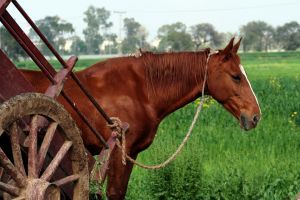 Considering how this horse is tied and what he’s tied to, all we need now is for someone to shout, “Fire in the hole!” and this train is bound for glory.
Considering how this horse is tied and what he’s tied to, all we need now is for someone to shout, “Fire in the hole!” and this train is bound for glory.
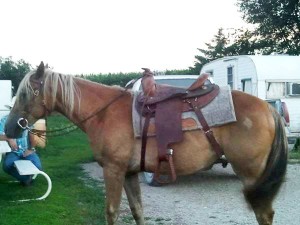 The poor horse! No front cinch at all; they have the latigo tied from one side to the other. And the back cinch? Too far back, and much too tight…this horse is a ticking time bomb.
The poor horse! No front cinch at all; they have the latigo tied from one side to the other. And the back cinch? Too far back, and much too tight…this horse is a ticking time bomb.
